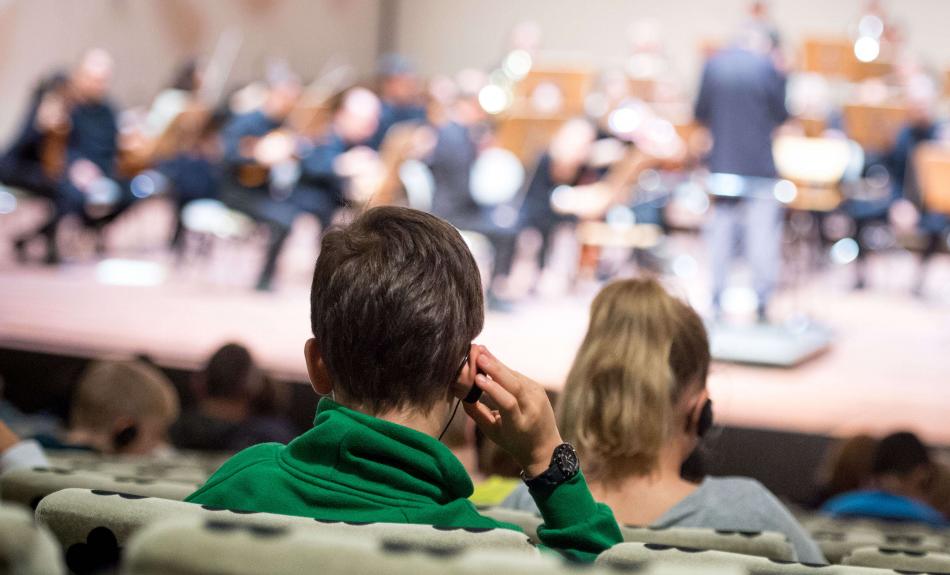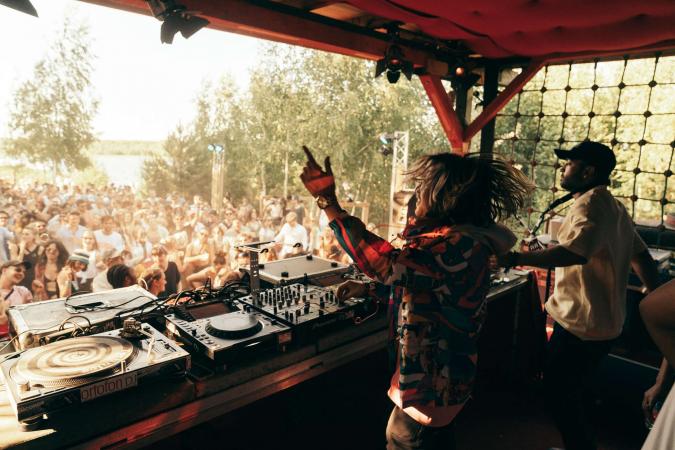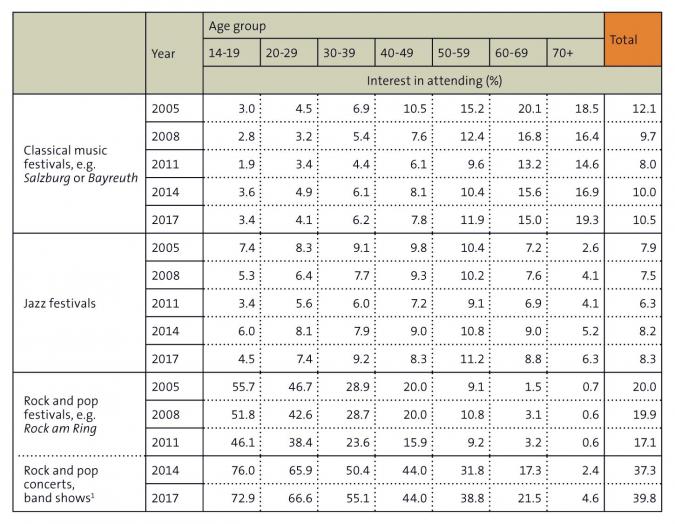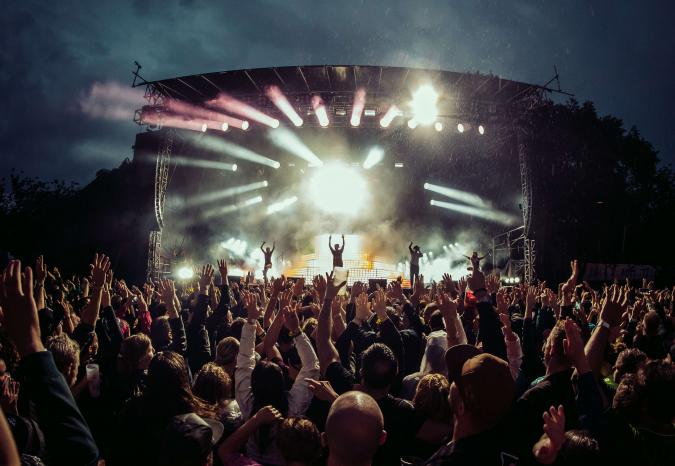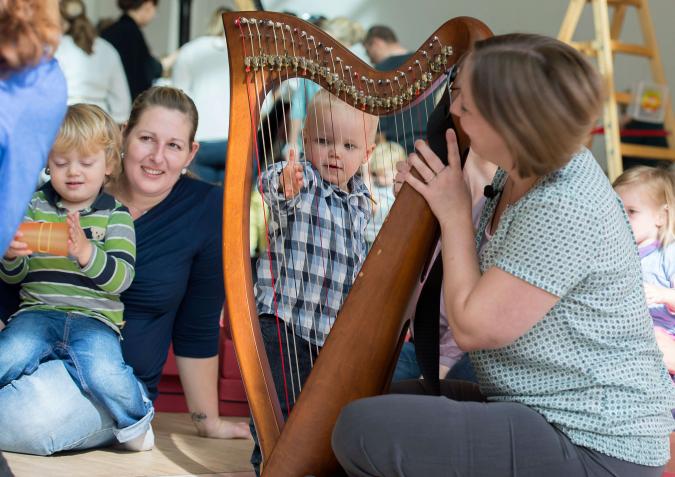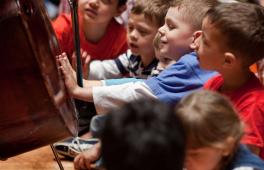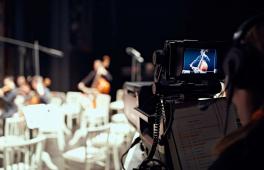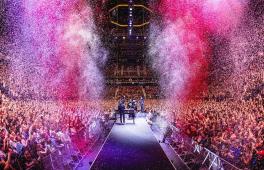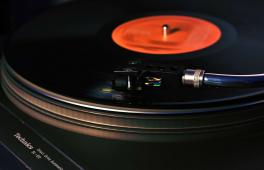Roughly three-quarters of all Germans hear music every day in their leisure time, and another 14 per cent do so every week. [1] Most often they hear it on the radio. But sound recordings such as CDs or MP3 files are likewise important: nearly one-third (32 per cent) of respondents in the most recent ‘Consumption and Media Analysis’ (Verbrauchs- und Medien-Analyse, or VuMA), an annual survey of the German-speaking population over the age of 14, listens to music several times a week on sound recordings such as CDs or MP3. [2]
Despite the universal importance of music in everyday life and society’s high opinion and active promotion of musical life in Germany, there is a shortage of empirical data. Little research has been done into how many people turn to music via which modes of reception and in what way, what their musical tastes are and how this has changed over time. Similar research deficits apply to the music business and its audience. The only data collected systematically and continuously, thus enabling us to describe trends, applies to publicly funded theatres in the form of attendance figures. How this applies to concerts or opera performances in places without established concert or theatre operations (e.g. guest performances from outside ensembles) is unknown. Nor are there any attendance figures for events in the world of popular music.
Methodologies in the study of cultural participation
The most frequently used and quoted statistics on musical life in Germany are the attendance figures gathered every year by the German Theatre and Orchestra Association (Deutscher Bühnenverein) as they relate to classical music, including operetta and musicals. [3] These figures, though generally referred to as ‘visitor statistics’, are in reality a combination of number of visitors and frequency of visits. A change in number of visits may reflect changes in both the number of visitors and the number of visits they make. In an extreme case an impression of stability may arise where none exists, namely, when the number of visitors and the frequency of visits change in opposite directions.
Attendance figures reach their limits when it comes to making statements about the visitors themselves, their social profiles and the frequency of their visits. Only general population and audience surveys are capable of supplying the relevant information. To do so, they must be based on selection procedures that satisfy scientific and statistical criteria and preclude self-recruitment of the respondents. Online surveys and other surveys that rely on various forms of self-recruitment are unsuitable for this purpose. [4]
Compared to audience surveys, general population surveys have the prima facie advantage of taking a sample from visitors as a whole, whether frequent or infre-quent. They also make it possible to capture not only the visitors but also the visitor potential, and to determine conditions for the emergence of cultural interests and the utilisation of cultural facilities. For conducting in-depth analyses of the more frequent visitors, general population surveys admittedly reach their limits owing to the restricted number of cases customary in survey research. Here audience surveys in cultural facilities offer a significant alternative or additional source. Surveys identify cultural participation by means of questions related to periods of time, e.g. whether the respondents attended an opera in the last 12 months or how frequently they do so (once a year, several times a year, etc.). Important here are the respondents’ powers of recollection, which are not always reliable. It may happen that events preceding the time frame are projected into it, thereby indicating something that lies further back in the past (‘telescoping effect’). This memory distortion, which also affects other topics, doubtless occurs more often in questions regarding high culture; after all, opera, concert halls and theatres enjoy high social esteem. Thus, it cannot be excluded that socially desirable response patterns create an inflated picture of participation on the part of the respondents, even if unconsciously.
As a rule, problems of recollection and/or social desirability patterns cause surveys to overestimate the number of visits. [5] This miscalculation most frequently in volves those visitors who rarely or irregularly attend concerts or opera performances. Respondents who state that they make use of a cultural facility several times a year are most likely to match the participants of audience surveys in cultural facilities, also as regards their social profile.
‘Musical taste is formed in young years both by the popular styles of the day and by the musical preferences of one’s parents, their social milieu, and school.’
Musical taste and cultural participation
Studies of musical taste
Our knowledge of the musical taste of a population, and how it changes over decades, is at best patchy. The earliest findings stem from listener research conducted by radio broadcasters. They focused on listeners in their own broadcasting area, worded their questions in different ways and only partly permit comparison with each other. [6] Surveys involving the population as a whole only came about decades later. The first was presumably a survey conducted by the Allensbach Demos copic Institute for the illustrated magazine Stern in 1980, [7] and thus three decades after the 1950s, when many new styles of popular music emerged in rapid succession. The information gap continued after 1980. Only since 1998 has the Allensbach Institute’s annual ‘Media Market Analysis’ (Allensbacher Markt- und Werbeträgeranalyse, or AWA) regularly asked questions about musical taste, albeit sometimes in slightly vague form (e.g. by conflating opera, operetta and Lieder into a single category).
Rarely do independent studies of culture or music ask questions about musical taste and reception. Among the few that did were the Kultur und Medien study, conducted by the ARD/ZDF Media Commission in 1989, and the ARD’s study of classical music in 2005. [8] Researchers in the latter study, besides querying opinions on musical styles worked with sound samples that the respondents were mean to judge. [9] To date, neither of these studies has found a continuation.
The most recent survey with questions on musical taste was the ALLBUS Study of 2014, which devoted a subset of questions to cultural and specifically to musical participation. The ALLBUS, an acronym for Allgemeine Bevölkerungsumfrage der Sozialwissenschaften (General population survey of the social sciences), offers the most detailed coverage of musical preferences to date on the level of verbally collected data. It is also available to researchers for secondary analyses through the GESIS Data Archive.
Studies of participation
Live performances are not as important in everyday life as other forms of music reception. Subjectively, however, they are all the more significant in their impact on the listener. Visits to them require a cultural infrastructure, i.e. opera houses or theatres for opera performances, concert halls and other venues, churches with musical events and so forth.
Compared to other countries, Germany’s cultural infrastructure is highly devel-oped. Nowhere else are there so many opera houses with their own ensembles and year-round operations. Today roughly one-third of the population (and probably somewhat more) has access to an opera house, or is occasionally offered performances from outside companies, near their home. [10] Still greater is the infrastructure for classical concerts: some 40 per cent of the population live within easy reach of a ‘concert hall or location where classical concerts (symphonies, chamber recitals) take place’. [11]
For a long time it was not known how frequently which circle of people made use of these cultural offerings. General population surveys that occasionally asked questions about cultural utilisation were imprecisely worded, mixing different cultural forms (e.g. theatre and concert) or remaining vague in questions of frequency. This only changed in 1985, when the Centre for Cultural Research (Zentrum für Kulturforschung, or ZfKf) began to ask about cultural participation in more sophisticated ways in their population surveys. (This later gave rise to the Kultur-Barometer series.) Other ZfKf surveys followed at irregular intervals, with the list of questions sometimes trimmed down and at other times expanded. Even so, once again the publications usually conflated several categories of music, so that, for example, developments in music theatre often failed to distinguish between opera, operetta and musical. [12]
The most recent nationwide study with details on attendance at musical and other cultural events stems from the year 2016 and was conducted for the Cultural Report of the State of North Rhine-Westphalia (Landeskulturbericht). [13] It covers the spectrum of cultural participation, not only in music, but also in other areas such as theatre and museums. It more precisely specifies the frequency of visits, thereby permitting a more comprehensive account of visitor potential.
Besides the above-mentioned nationwide studies, information on visits to musical and other cultural events can occasionally be obtained from local surveys, usually initiated by the statistical bureaus or culture departments of the cities concerned. However, they are often of limited use for the questions we raise here, for they merely seek to register the utilisation of municipal facilities such as concert halls and make no distinction between the types of events offered there.
Besides population surveys, the second major source of information on the public for music and culture is audience surveys conducted at the site of an event. The most extensive project on musical life, as based on audience surveys, stems from Rainer Dollase and co-workers in the 1970s and covers rock and jazz concerts as well as opera performances and classical concerts. [14] To be sure, only a few performances were selected per genre (thus partly failing to meet the criteria of representativity), but at least the heterogeneity of musical performance was taken sufficiently into account. Since then, with a few minor exceptions, [15] no similarly broad approaches based on visitor polls have been carried out.
Nor have there been, for a long time, any studies of a single location under similar survey conditions. The only exception (taking Rainer Dollase’s and Michael Behr’s studies as the point of departure) relates to the opera audience in Cologne and in North Rhine-Westphalia. These replications made it possible, for the first time, to pursue questions of long-term changes in the opera audience in greater depth. [16]
Trends in musical taste
Current information on musical taste is provided in a more sophisticated form by the ALLBUS of 2014. [17] Here pop music emerges as the favourite musical genre of 62 per cent of the population, followed by rock music (56 per cent) and classical music and musicals (50 per cent each). Operas are heard ‘with great pleasure’ or ‘with pleasure’ by 25 per cent of the population, or even 45 per cent if we include the neutral response ‘with neither pleasure nor displeasure’.
A similar order to that of music preferences can be found with regard to classical music festivals (see Fig. 1). Here the figures are lower, reflecting the fact that many festivals are expensive to attend, thereby frightening off many potentially interested visitors. Moreover, some festivals, such as those in Salzburg and Bayreuth, have an aura of exclusivity that keeps many music lovers from developing a serious interest in them.
That roughly half of Germany’s population appreciates classical music is not a dis-covery unique to the ALLBUS survey. Similar findings have been found in surveys whose questions are worded in a slightly different way. In 2013, for example, 49 per cent of respondents in a ‘forsa’ survey for the Körber Foundation answered ‘Yes’ to the question ‘I like classical music, e.g. pieces by Mozart or Beethoven’. A similarly high percentage was shown by studies presenting samples of music to be rated by likeability. For instance, 55 per cent of respondents in the ARD study on classical music (2004-05) proved receptive to this music. [18] Representative population sur-veys in such cities as Düsseldorf and Hamburg likewise revealed that roughly half the population judged classical music to be very good or good. [19]
Significantly lower percentages emerged from the surveys of the AWA series. While every second respondent in ALLBUS 2014 claimed to take ‘great pleasure’ or ‘pleasure’ in listening to classical music, the AWA survey of the same year found this true only of every third respondent (34 per cent). The main reason for this probably lies in the way the question was worded. Instead of ‘classical music’, the AWA survey speaks of ‘classical music, piano concertos, symphonies’. [20] This seems at first glance to be more specific and meaningful, but the use of the term ‘piano concertos’ sets specific emphases and presumably narrows the frame of reference for many respondents. Viewed in this light, the figures represent a lower limit and tend to indicate a ‘hard core’ of classical music fans rather than a more general cross-section of interested listeners.
Nevertheless, the AWA and its findings are important for the questions raised here. It is the only national series of surveys that covers a period of several decades on the basis of a large number of respondents. According to its figures, the number of classical music lovers dropped in all age groups between 1996 and 2016 (see Fig. 2). The only exceptions were those over the age of 60, who revealed de facto the same percentage in 2016 as they had 20 years earlier. The decline basically occurred in the years between 1996 and 2006; it is less steep in the years that follow, where the corresponding figures in several age groups sometimes even remained stable. This does not necessarily imply, however, that the downward trend has come to an end, but only that we cannot proceed from a constant rate of change, and that the trends cannot be projected linearly. Fluctuations and delayed developments owing to period- and generation-specific events and influences (among other things) are a normal component of social change.
Moreover, when we examine the subdivisions by ten-year age groups, we notice a ‘cohort effect’ for classical music: each new generation reveals a lower appreciation of classical music than its predecessor and basically retains its musical imprint as it grows older. In 1996, for example, 31 per cent of those between 20 and 29 years of age stated that they take ‘great pleasure or ‘pleasure’ in listening to classical music. Ten years later, when they were between 30 and 39, the figure had dropped to 26 per cent. But another ten years later (between 40 and 49) it had rebounded to 29 per cent, and was thus roughly the same as the initial figure. A similar stability, based on the figures for 1996, can be observed in the age groups from 30 to 39 and from 40 to 49, even though they proceed from slightly different initial levels. Only the age group from 20 to 29 in 2006 had a higher figure ten years later when they were 30 to 39 years old.

The situation is more complex in the case of ‘Opera, operetta and songs’. The 20- to 29-year-olds and 30- to 39-year-olds of the year 1996 retained their cohort level as time passed, whereas the percentages rose for the groups from 40 to 49 and from 50 to 59. Whether this related to opera, operetta or songs, or to all three, is a moot question. It is conceivable that lovers of classical music, who tend to view these genres with some scepticism, acquire a more lenient attitude toward them as they gather more experience, leading to a certain positive assessment with the passage of time.
The relation that these findings on musical taste bear to actual reality can be seen in the figures from the AWA surveys of 1996 to 2002 on listening to classical music (the question of frequency was dropped after 2002). Again we notice an erosion in the number of people in favour of classical music, disproportionately so among younger listeners. As late as 1994, 50 per cent of 20- to 29-year olds claimed to listen to classical music ‘frequently’ or ‘now and then’; eight years later the figure for the same age group had dropped to 40 per cent. In the same time period the decline among 30- to 39-year-old and 40- to 49-year-olds amounted to a mere 2 to 4 per cent, and it even rose slightly for those over the age of 50.
For the next time period, from 2002 to 2012, the process can be followed using the nationwide surveys of the ‘Consumption and Media Analysis’ (VuMA), [21] albeit with the questions worded slightly differently. Once again the number of classical listeners dropped disproportionately among younger respondents. If 46 per cent of those younger than 30 claimed to listen to classical music frequently or occasionally in 2002, [22] by 2012 this figure had plunged to 32 per cent, a decline of one-third.
These findings suggest a creeping decline in the appreciation of classical music, and in listening to classical music altogether. Presumably it is part of a long-term trend. This is also implied by the results of recall questions regarding musical taste in young years, which suggest that intergenerational differences in the appreciation of classical music already existed in earlier times. [23]
The fate of classical music is influenced not only by the declining number of listeners in each subsequent generation but by demographic changes in society itself. In 2016 there were roughly 17 per cent fewer people between 25 and 45 years old than there were between 45 and 65. Moreover, each new generation has a higher proportion of individuals with a migration background, who are less likely to have a love of classical music. In light of both these factors, the potential demand for classical music in the future must be set even lower than the changes in the size of later cohorts.
Musical taste and social structure
Musical taste is formed in young years both by the popular styles of the day and by the musical preferences of one’s parents, their social milieu, and school. The fact that appreciation of classical music and opera rises with level of education is the result of coming from higher social strata and from grammar schools (Gymnasien), which usually attach a higher value to music instruction than other types of school. [24] But an appreciation of classical music is also partly a consequence of influences and social expectations widespread among the more educated classes and their social milieu. The extent to which social distinction tendencies are also involved (i.e. a separation from other social layers through the cultivation of musical expertise and corresponding ‘impression management’) [25] is open to debate. Presumably such purposes are likely to be served today by other forms of cultural prestige, particularly from the visual arts.
Besides education and class affiliation, musical taste is significantly influenced by age and generation. Pop and rock music, heavy metal and other more recent styles are disproportionately liked by younger people, classical music and opera by older people (see Fig. 3). Mixed forms of musical preferences are especially noticeable in the breakdown by age group. This is especially apparent in respondents with a predilection for classical music: [26] younger respondents combine a preference for classical music with rock and other newer styles more frequently than older respondents, who tend to combine it with folk music and German pop songs (Schlager).
Though mixed forms of musical taste predominate, lines of demarcation are also made visible. Those who take ‘great pleasure’ in listening to classical music have a more negative view of non-classical styles, such as rock, pop, folk and Schlager, than those who merely take ‘pleasure’ in it. And the latter in turn have a more negative attitude toward popular genres than those with a neutral or ambivalent opinion of classical music. In short, the greater the appreciation of classical music, the larger the fault lines toward other styles.
Finally, the tendency to draw boundaries appears greatest among those who attend classical concerts or opera performances. According to the ALLBUS survey, 31 per cent of those who take ‘great pleasure’ in listening to classical music also take ‘great pleasure’ or ‘pleasure’ in German folk music, whereas among those who attend classical concerts or opera productions the figure plunges to 6 or 7 per cent. [27] Much the same applies to Schlager, which are valued by only 3 to 6 per cent of opera and concert visitors. The stronger the ties to classical music, the lower the tendency to extend the same appreciation to other musical genres.
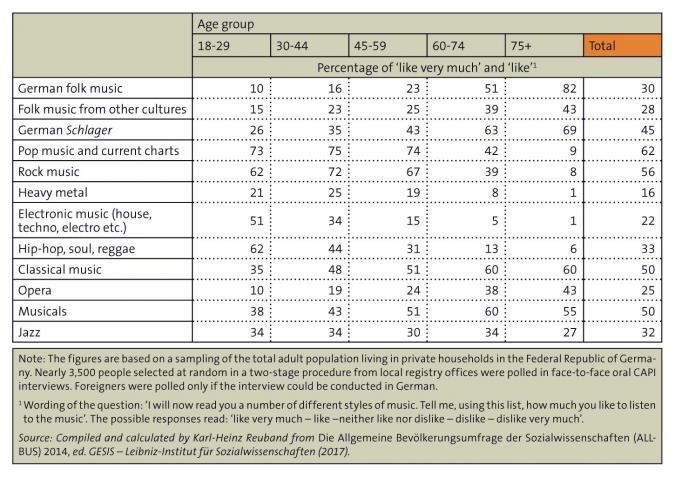
Distribution and social characteristics of opera and concert visitors
Some 10 per cent of the population of Germany attend, by their own account, one or more opera performances each year (see also Fig. 4). This percentage is more than twice as high in cities with an opera house, such as Düsseldorf, Leipzig or Hanover. [28] Owing to the larger number of opportunities and greater appreciation, this annual percentage is higher for classical concerts than for opera, amounting to 18 per cent in 2016. Moreover, 22 per cent of respondents claimed to attend at least one organ recital or choral concert in church each year. Adjusting for multiple responses, this brings us to a total of 28 per cent for both.
The figures are even higher when the other categories of music participation are included in the calculation. The percentage of individuals in the overall population who attend one or more events with (mainly) classical music in the course of a year (opera, classical concert, organ recital, choral concert, musical, dance or ballet) amounts to 44 per cent – more than is the case with rock, pop or jazz (excluding concerts of folk music or Schlager). This percentage is halved to 21 per cent when related to multiple visits each year. However, there is no change in basic ratios: as before, it exceeds the percentage of visitors to rock, pop and jazz concerts and those who visit museums more than once a year.
Visitors to musical events do not constitute a representative cross-section of the population. As we might expect from musical taste, older persons and those with a higher level of education are over-represented in the opera and concert audience, but under-represented among visitors of rock, pop and jazz concerts, albeit to different degrees.
There is much evidence to suggest that a person’s social characteristics may have an impact of their own, independent of musical taste. In this case, age and educa-tion have a (rather weak) impact even when the appreciation of classical music is considered as an influencing factor. [29] Presumably this reflects the normative expectations of the individual’s interpersonal environment as well as a specific life style: those who cultivate a highly cultured life style are often disproportionately inclined to attend concerts or opera performances even if they are less interested in classical music per se. Much the same can be said, as a rule, of the impact of income level on frequency of concert and opera visits. This also applies, in general, when we consider that educational level and income are correlated, and that the impact of income may partly reflect that of education.
Whether low-level, affordable or free access makes attendance at classical events more attractive to younger or less well-educated people, as is often assumed, is open to question. A study conducted in Munich suggests that although the free open-air events of the Bavarian State Opera appeal to a younger and more socially heterogeneous audience than the standard opera public, the percentage of previous non-visitors remains limited. Similarly, an analysis of the audience of opera broadcasts in cinemas reveals that the audience is neither different, nor younger, nor socially more heterogeneous than in the opera house. Here the older and more highly educated group continues to be over-represented compared to the rest of the population. Its average age is even higher than that of the opera public. [30]
That opera and concert audiences are disproportionately old and are becoming older was not always the case. During the 1970s their average age was lower than that of the population. [31] Musical taste and its changes over time provide only a limited or no explanation for the transformation. Rather, the development reflects a fundamental restructuring of cultural participation as a whole. Besides opera and classical concerts, this also affects visits to theatres and museums, the difference being that the process there began at a lower level and may perhaps proceed some-what more slowly.
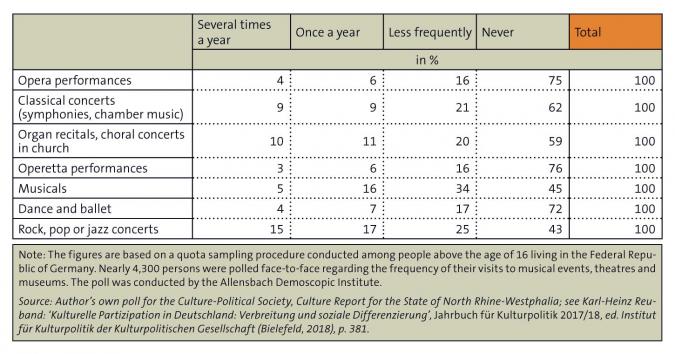
A closer analysis suggests that the disproportionate rise in the average age of the cultural public in recent decades has resulted from two factors: a growing disinclination to participate among younger people, and a greater willingness to participate among older people. [32] The reasons why younger people are with drawing from culture is largely open to guesswork. Besides changes in musical taste, this development is probably affected by changes in life style and new leisure pursuits. In the case of older people, a change in the role and the self-image of the elderly probably also contributed to the increase in cultural participation. Today older people are more active than in earlier generations. Advanced age no longer means, as it once did, withdrawing and adopting a passive life style.
Conclusions
Music listeners have mixed musical tastes with various combinations of styles and different points of emphasis depending on their generational affiliation. New configurations arise as each new generation emerges and older ones depart, with the result that specific musical styles witness an upswing or a downturn.
Roughly half of Germany’s population is receptive to classical music, though the trend points downward. Owing to the declining appreciation for classical music in younger generations, the audience for classical music is threatened by a process of erosion. Together with changes in the demographic structure of society, this means that cultural institutions for the performance of classical music will be affected in the long run. Whether the special music appreciation programmes for young people that have evolved in recent years in schools, opera houses and orchestras [33] will be able to halt or even reverse this development remains to be seen. Even if activities along these lines are successful, their impact will not be immediate: it will only take effect in the long run, during which time the average age of the audience will, at first, continue to grow.
The disproportionate aging of the opera and concert audience has a counterpart in the aging of theatre and museum visitors. It is a sign of a fundamental cultural shift and, in this light, more a general symptom than a mirror-reflection of a development specific to music. To understand this shift and respond to it in an appropriate manner, it will be essential in the future not to consider it in isolation, but to view and study it within the context of general changes in society and culture.
Footnotes
Horst Baumann and Sonja Schulz, ALLBUS 2014 – Variable Report (Cologne, 2018), p. 13.
Arbeitsgemeinschaft Verbrauchs- und Medienanalyse, ed., Basisdokumentation VuMATouchpoints 2019, Berichtsband VuMA 2019 (Frankfurt am Main, 2018), p. 90.
German Theatre and Orchestra Association, ed., Theaterstatistik (Cologne, 1967- ).
For this reason the study presented by concerti in 2016 cannot be seen as representative. See also the explanations in the study itself regarding the design of the investigation. Michael Haller and Johannes Truss, ‘Typisch Klassik!’: concerti Klassikstudie 2016: Eine Repräsentativbefragung über Interessen, Gewohnheiten und Lebensstile der Klassikhörer in Deutschland (Hamburg, 2016), online at https://miz.org/sites/default/files/documents/2016_concerti_Klassikstudie_2016.pdf (accessed on 21 November 2018)
See Karl-Heinz Reuband, ‘Partizipation an der Hochkultur und die Überschätzung kultureller Kompetenz: Wie sich das Sozialprofil der Opernbesucher in Bevölkerungs- und Besucherbefragungen (partiell) unterscheidet’, Österreichische Zeitschrift für Soziologie 3 (2007), pp. 46-70; and idem, ‘Entwicklungstendenzen und Struktureffekte kultureller Partizipation: Eine Analyse am Beispiel der Stadt Düsseldorf’, in Institut für Kulturpolitik der Kulturpolitischen Gesellschaft, ed., Jahrbuch für Kulturpolitik 2015/16 (Bielefeld, 2016), pp. 417-32
See Elisabeth Noelle and Erich Peter Neumann, eds., Jahrbuch der öffentlichen Meinung 1946–1955 (Allensbach, 1956), pp. 62 and 76.
Selected findings by age group are reproduced in Elisabeth Noelle-Neumann and Edgar Piel, eds., Allensbacher Jahrbuch der Demoskopie 1978–1983 (Munich, 1983), p. 34.
Bernhard Frank et al., Kultur und Medien: Angebote – Interessen – Verhalten (Baden-Baden, 1991); Annette Mende and Ulrich Neuwöhner, ‘Wer hört heute klassische Musik?’, Media Perspektiven 5 (2006), pp. 246-58.
Josef Eckhardt et al., ‘Besucherpotential von Opernaufführungen und Konzerten der klassischen Musik’, Media Perspektiven 5 (2006), pp. 273-82.
Karl-Heinz Reuband, ‘Kulturelle Partizipation in Deutschland: Verbreitung und soziale Differenzierung’, in Institut für Kultur politik der Kulturpolitischen Gesellschaft, ed., Jahrbuch für Kulturpolitik 2017/18 (Bielefeld, 2018), pp. 377-93, esp. p. 383
See the same 2016 survey as in note 10 (both nationwide). The question was worded: ‘Which of the following event sites or facilities are located in your city ...?’ (the wording used for concert events is enclosed in quotation marks in the text). Sources: the present writer’s own survey for the Culture-Political Society, Cultural Report of the State of North Rhine-Westphalia (‘Landeskulturbericht’) (2016).
Susanne Keuchel, ‘Abwärtstrend gestoppt: Nachwuchsarbeit muss dennoch weiter intensiviert werden’, Präsentation des 9. Kultur-Barometers, Deutsche Orchestervereinigung/Zentrum für Kulturforschung (Berlin, 2011).
Reuband, ‘Kulturelle Partizipation in Deutschland’ (see note 10), pp. 377-93.
Rainer Dollase et al., Rock People oder Die befragte Szene (Frankfurt am Main, 1974); idem et al., Das Jazzpublikum: Zur Sozialpsychologie einer kulturellen Minderheit (Mainz, 1978); idem et al., Demoskopie im Konzertsaal (Mainz, 1986); Michael Behr, Musiktheater – Faszination, Wirkung, Funktion (Wilhelmshaven, 1983).
Hans Neuhoff, ‘Die Altersstruktur von Konzertpublika: Querschnitte und Längsschnitte von Klassik bis Pop in kultursoziologischer Perspektive’, Musikforum 95 (2001), pp. 64-83. On the jazz audience see Fritz Schmücker, Das Jazzkonzertpublikum: Das Profil einer kulturellen Minderheit im Zeitvergleich (Münster, 1993). On audiences for musicals, opera and classical concerts see Karl-Heinz Reuband, ‘Das Kulturpublikum im städtischen Kontext: Wie sich das Opernpublikum von anderen Kulturpublika unterscheidet’, in idem, ed., Oper, Publikum und Gesellschaft (Wiesbaden, 2018), pp. 143-91.
Karl-Heinz Reuband, ‘Wie hat sich das Opernpublikum in den letzten Jahrzehnten in seiner sozialen Zusammensetzung verändert? Eine Analyse am Beispiel der Kölner Oper’, Sociologia Internationalis 51 (2013), pp. 231-66; idem, ‘Konstanz und Wandel in der Sozialstruktur des Opernpublikums: Ein Langzeitvergleich auf der Basis von Publikumsbefragungen in Nordrhein-Westfalen von 1979 bis 2012’, in Institut für Kulturpolitik der Kulturpolitischen Gesellschaft, ed., Jahrbuch für Kulturpolitik 2013 (Essen, 2013), pp. 409-22.
The present writer’s own analysis of ALLBUS 2014.
forsa: Klassische Musik, Tabellenband (Berlin, 2013), p. 1 (unpubd.). The ARD study is discussed in Mende and Neuwöhner, ‘Wer hört heute klassische Musik?’ (see note 8). See also Karl-Heinz Reuband, ‘Wie viele Hörer klassischer Musik gibt es in der Bevölkerung? Widersprüchliche Befunde empirischer Studien, und was diese über das Muster der Musikrezeption aussagen’, Sociologia Internationalis 51 (2013), pp. 25-37.
See inter alia Karl-Heinz Reuband, ‘Konzertbesuch im Aufschwung oder Niedergang? Der Einfluss von Alter, Generationszugehörigkeit und Bildung auf den Besuch klassischer Konzerte’, Sociologia Internationalis 49 (2011), pp. 199-225, esp. p. 214.
ALLBUS has five response categories (with a middle category ‘neither pleasure nor displeasure’), AWA only four. Normally the use of five categories will lower the percentage of approval vis-à-vis four categories. That this is not the case is further evidence that the wording of a question affects the results.
The above-mentioned AWA statistics on listening to music were kindly provided to the present writer by the Allensbach Demos copic Institute. The findings of the VuMA can be taken from the table volumes, online at https://www.vuma.de (accessed on 12 November 2018).
Here the categories ‘several times a week, several times a month, roughly once a month, less often’ are combined. The AWA survey used frequency indications without a precise temporal reference (‘frequently, now and then’ etc.). A direct comparison of the figures is therefore impossible.
Reuband, ‘Konzertbesuch im Aufschwung oder Niedergang?’ (see note 19).
Heiner Gembris, ‘Entwicklungsperspektiven zwischen Publikums-schwund und Publikumsentwicklung: Empirische Daten zur Musikerausbildung, dem Musikerberuf und den Konzertbesuchern’, in Martin Tröndle, ed., Das Konzert: Neue Aufführungskonzepte für eine klassische Form (2nd edn., Bielefeld, 2011), pp. 61-82.
Pierre Bourdieu, Die feinen Unterschiede: Kritik der gesellschaftlichen Urteilskraft (Frankfurt am Main, 1982).
The following findings derive from my own analyses of ALLBUS data for the present essay, where they are not separately listed in tabular form.
The following findings derive from the analysis of my own surveys of the opera and concert audiences in Cologne and Düsseldorf.
The following figures stem from Reuband, ‘Kulturelle Partizipation’ (see note 10).
Karl-Heinz Reuband, ‘Teilhabe der Bürger an der “Hochkultur”: Die Nutzung kultureller Infrastruktur und ihre sozialen Determinanten’, in Anton Labisch, ed., Jahrbuch der Heinrich-Heine-Universität Düsseldorf 2005/06 (Düsseldorf, 2006), pp. 263-83, online at http://dup.oa.hhu.de/253 (accessed on 11 December 2018)
Jörn Hering, ‘Neue Wege für ein neues Publikum? “Open-Air” Veranstaltungen als Einstieg in das Opernerlebnis – das Beispiel Bayerische Staatsoper’, in Reuband, ed., Oper, Publikum und Gesellschaft (see note 15), pp. 355-73; Karl-Heinz Reuband, ‘Junges Publikum für Puccini? Opern im Kino und ihre Zuschauer: empirische Befunde und offene Fragen’, in das Orchester 12 (2018), pp. 20-23.
On the following see Reuband, ‘Opernpublikum’ (see note 16)
Karl-Heinz Reuband, ‘Die Neustrukturierung der Altersbeziehung kultureller Partizipation: Ein Langzeitvergleich bundesweiter Bevölkerungsumfragen, 1972–2016’, Zeitschrift für Kulturmanagement 1 (2018), pp. 23-54.
See also Gembris, ‘Entwicklungsperspektiven’ (see note 24).
